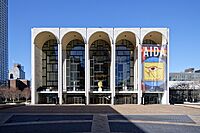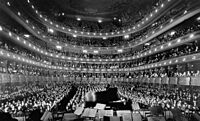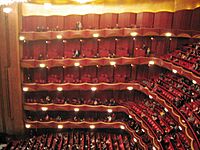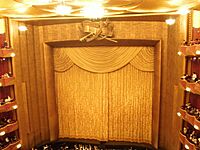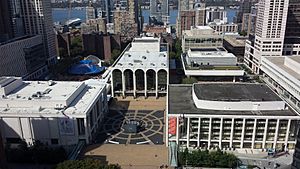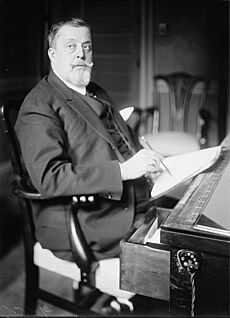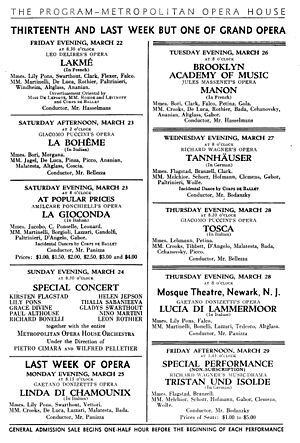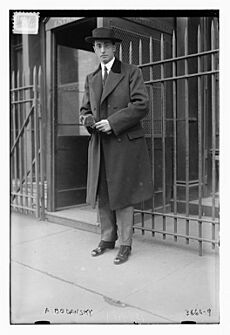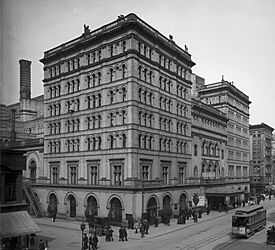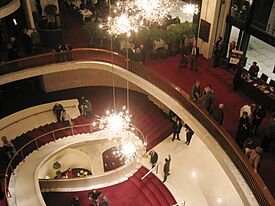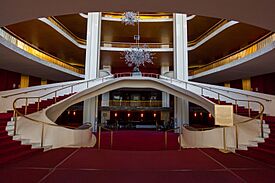Metropolitan Opera facts for kids
The Metropolitan Opera is a famous American opera company. It is located in New York City at the Metropolitan Opera House in Lincoln Center. People often call it the Met. It is run by a non-profit group called the Metropolitan Opera Association. Peter Gelb is the general manager. The music director, who leads the orchestra, has been Yannick Nézet-Séguin since 2018.
The Met started in 1883. It was created as a new option for opera lovers. Before that, the Academy of Music was the main opera house. The Met first opened in a new building on 39th and Broadway. This building is now known as the "Old Met." In 1966, the company moved to its current home at Lincoln Center.
The Metropolitan Opera is the biggest classical music group in North America. Each year, the company performs about 18 different operas. Their season runs from late September to early June. They perform operas on a rotating schedule. This means they might show up to seven performances of four different operas each week. Shows are usually in the evening from Monday to Saturday. There is also a show on Saturday afternoons. Sometimes, there are Sunday afternoon shows too.
Some operas each season are brand new productions. These might be borrowed or shared with other opera companies. Other operas are older shows brought back from previous seasons. For example, in the 2015–16 season, they performed 227 shows of 25 different operas.
The Met performs many types of operas. These include older works from the 1700s and 1800s. They also perform modern operas from the late 1900s and 2000s. The shows can have grand, traditional sets. Or they might have modern, artistic designs.
The Met has a large group of performers. This includes a big symphony orchestra and a chorus. They also have a children's choir. Many solo singers, both famous international artists and American ones, perform with the Met. Some singers start their careers in the Met's young artist programs. Many performers work with the Met for a long time.
Contents
History of the Met Opera
The Metropolitan Opera Company began in 1883. It was meant to be a new choice for opera in New York. The older Academy of Music was very exclusive. Wealthy new families in New York felt left out. They decided to build a new opera house. This new house would be even better than the old Academy.
On April 28, 1880, 22 men met to plan the new company. They wanted a theater with many private boxes. These boxes would let new wealthy families show their importance. Families like the Morgans, Roosevelts, and Vanderbilts were among the first supporters. They had all been kept out of the Academy.
The new Metropolitan Opera House opened on October 22, 1883. It was a big success. The Academy of Music's opera season closed just three years later.
First Performances
In its early years, the Met hired managers to put on the opera seasons. Henry Abbey was the manager for the first season, 1883–84. The first show was Faust by Charles Gounod. The famous singer Christina Nilsson starred in it.
Abbey's company had many great singers. They performed 150 shows of 20 different operas. These included works by Gounod, Verdi, and Wagner. All the performances were sung in Italian. Auguste Vianesi or Cleofonte Campanini conducted them.
The company also started touring other cities. In 1884, they performed in Brooklyn, Boston, and Philadelphia. They also visited Chicago, St. Louis, and Washington D.C. Abbey's first season lost a lot of money.
Met Opera in Philadelphia
The Met performed in Philadelphia for almost 80 years. Their first Philadelphia show was Faust in January 1884. They would take the whole company to Philadelphia on certain Tuesday nights. Most shows were at Philadelphia's Academy of Music. By 1961, they had performed nearly 900 times there.
In 1910, the Met bought the Philadelphia Opera House. They renamed it the Metropolitan Opera House. They performed there until 1920. Then they sold the theater and went back to the Academy of Music.
Over the years, the number of Philadelphia performances decreased. The last show there was on March 21, 1961. It was Turandot with Birgit Nilsson and Franco Corelli. The Met still visited Philadelphia on spring tours in later years.
German Opera Seasons
For its second season, the Met chose Leopold Damrosch as general manager. He was a respected conductor. He decided the opera company would perform only in German. The company had famous singers from German opera houses. They were very successful with works by Wagner and other German composers. They also sang Italian and French operas in German.
Damrosch died a few months into his first season. Edmund C. Stanton took over the next year. He was general manager until 1891. The Met's six German seasons were known for performances by Anton Seidl. His Wagner interpretations were very powerful. Walter Damrosch, Leopold's son, also began his long connection with the Met during this time.
Early Recordings
From 1900 to 1904, Lionel Mapleson made recordings at the Met. He was a violinist and music librarian for the Met. He used an Edison phonograph to record short parts of performances. These recordings are called the Mapleson Cylinders. They let us hear what the early Met sounded like. They are the only recordings of some singers from that time. These recordings were later added to the National Recording Registry.
Touring Across the Country
Starting in 1898, the Met company went on a six-week tour each spring. They visited American cities that did not have their own opera companies. These tours brought the Met and its stars to many places.
For example, in Cleveland, the Met started regular performances in 1924. This led to the creation of the Northern Ohio Opera Association. This group helped fund the Met's tours. Cleveland was a good stop for the Met. There was no local opera company, and performances were held in a huge auditorium. The Met's national tours continued until 1986.
The Met has also toured other countries. In 1910, they visited Paris. In 2011, they toured Japan. This was their seventh tour there since 1975. They performed after a big earthquake and tsunami in Japan. They showed operas like Puccini's La Bohème.
In 2023, the Met Orchestra started touring again. They went to London, Paris, and Baden-Baden. This was their first European tour in over 20 years. In 2024, the orchestra toured Asia for the first time. They performed in Seoul, Hyogo, Tokyo, and Taipei.
Met Opera Leaders
Early Leaders
Italian opera returned to the Met in 1891. This was a season full of stars. It was organized by Henry E. Abbey, John B. Schoeffel, and Maurice Grau. After a fire in 1892, the opera house was rebuilt. Abbey and Grau continued as managers. This time is called the "Golden Age of Opera." Many of the world's best opera singers performed at the Met. They sang in Italian, German, and French.
Some famous singers included Jean and Édouard de Reszke, Lilli Lehmann, and Nellie Melba. Henry Abbey died in 1896. Maurice Grau was the only manager from 1896 to 1903.
In the early 1900s, the Met had separate groups of singers for Italian, German, and French operas. This changed after World War II. Singers then spent less time with one company.
Heinrich Conried
Heinrich Conried was in charge from 1903 to 1908. During his time, the famous tenor Enrico Caruso joined the Met. Caruso was one of the most celebrated singers at the old Met. Conried also hired conductor Arturo Vigna.
Giulio Gatti-Casazza
After Conried, Giulio Gatti-Casazza led the Met for 27 years, from 1908 to 1935. He came from leading the La Scala Opera House in Milan. His great planning and organization made the Met a place of new ideas and excellent music. He brought the brilliant conductor Arturo Toscanini with him.
Many famous singers performed under Gatti-Casazza. These included sopranos Rosa Ponselle and Elisabeth Rethberg. Tenors like Giovanni Martinelli and Beniamino Gigli also sang there. Baritones Titta Ruffo and Giuseppe De Luca were also part of the company.
Toscanini was the Met's main conductor from 1908 to 1915. He set high standards for the company. The composer Gustav Mahler also conducted at the Met for two seasons. Later, conductors Tullio Serafin and Artur Bodanzky led the Italian and German operas.
Gatti-Casazza guided the company through World War I. The 1920s brought new shows and success. But the 1930s brought money problems. In 1931, Otto Hermann Kahn, a rich financier, left his role as head of the Met's board. Paul Drennan Cravath, a lawyer, took over. He focused on the business side.
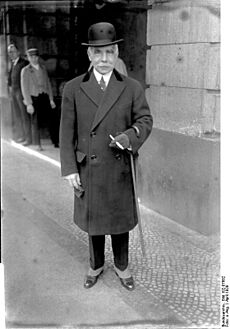
A plan to move the opera house to Rockefeller Center was considered in 1926. But it was dropped in 1929. The Wall Street Crash of 1929 and the Great Depression caused big money problems for the Met. Ticket sales were good, but rich supporters gave less money.
Cravath found new ways to get money. He made a deal with the National Broadcasting Company (NBC). This allowed weekly radio broadcasts of Met performances. The first national broadcast was on December 25, 1931. It was Hansel and Gretel. Cravath also cut salaries by ten percent. He changed the company from a corporation to an association. This helped save money.
In 1932, the Met still had money problems. A committee was formed to raise money from the public. They asked radio listeners for help. The popular singer Lucrezia Bori led this group. Her efforts raised enough money for the 1933–34 season.
Edward Johnson
In April 1935, Gatti-Casazza left. His replacement, Herbert Witherspoon, died shortly after. So, Canadian singer Edward Johnson became general manager. He led the Met for 15 years, through the rest of the Depression and World War II.
Money problems continued. Fundraising efforts kept the Met going. The number of performances was reduced. But shows with Kirsten Flagstad and Lauritz Melchior were very popular. To get more support, Eleanor Robson Belmont started the Metropolitan Opera Guild. This group supported the Met through its magazine, Opera News, and radio appeals. In 1940, the Met became a non-profit organization.
Many new singers joined the Met under Johnson. These included Zinka Milanov and Jussi Björling. During World War II, many European artists were not available. So, the Met hired more American singers. Eleanor Steber, Helen Traubel, and Richard Tucker became stars. Famous conductors like Sir Thomas Beecham and Bruno Walter also worked there. Kurt Adler became the chorus master in 1943.
Rudolf Bing
Rudolf Bing took over from Johnson in 1950. He had created the Edinburgh Festival. Bing was general manager until 1972. He made many important changes. He updated how the company was run. He also ended the Met's Tuesday night shows in Philadelphia. He led the company during a time of great singing and new productions. He also oversaw the move to the new Lincoln Center home.
Bing opened the Met's stage to singers of color. Marian Anderson made history with her debut in 1955. After her, many talented African American artists joined. These included Leontyne Price (who opened the new Lincoln Center house), Grace Bumbry, and Martina Arroyo. Other famous singers who debuted under Bing include Roberta Peters, Renata Tebaldi, Maria Callas, Birgit Nilsson, Joan Sutherland, Luciano Pavarotti, and Plácido Domingo.
The Met's 1961 production of Turandot was a huge success. It starred Birgit Nilsson and Franco Corelli. In 1963, the Metropolitan Opera National Company (MONC) was created. This was a second touring company for young singers. It performed in many cities across the U.S. Bing supported it publicly but worked to close it down. The MONC stopped performing in 1966.
During Bing's time, the Met and the New York Philharmonic worked together. They built the Lincoln Center for the Performing Arts. The new Metropolitan Opera House opened there in 1966.
The first season at Lincoln Center had nine new productions. One was the world premiere of Marvin David Levy's Mourning Becomes Electra. The Met did not premiere many new operas for decades after this.
Leaders After Bing
After Bing retired in 1972, several people shared leadership. The person meant to take over, Göran Gentele, died in a car accident. Schuyler Chapin then served as general manager for three seasons. A big achievement was the Met's first tour to Japan in 1975. This tour helped make opera popular in Japan. It had great singers like Marilyn Horne and Luciano Pavarotti.
From 1975 to 1981, three directors led the company. Anthony A. Bliss was general manager. James Levine was artistic director. John Dexter was director of production. Levine became the Met's main artistic leader for many years.
In the 1983–1984 season, the Met celebrated its 100th anniversary. They had a special concert called the Centennial Gala. It lasted eight hours and was shown on TV. Many current and past Met stars performed. Leonard Bernstein and Birgit Nilsson gave their last performances with the company at this concert.
More African-American singers became leading artists. Kathleen Battle became a star in lyric soprano roles. Simon Estes began his Met career in 1982.
Joseph Volpe
Joseph Volpe became general manager in 1990. He was the third-longest serving manager. He started at the Met as a carpenter in 1964. Under Volpe, the Met toured more internationally. Levine focused on making the Met's orchestra world-class. The Met also performed many new works under Volpe. He chose Valery Gergiev as Principal Guest Conductor in 1997. This expanded the Met's Russian operas.
Many new artists were first heard at the Met during Volpe's time. These included Renée Fleming, Juan Diego Flórez, and Anna Netrebko. Volpe retired in 2006.
Peter Gelb
Peter Gelb, a former record producer, became general manager in 2006. He wanted more new productions each year. He also aimed to attract new audiences. Gelb felt these changes were important for the Met.
Gelb started his time by opening the 2006–2007 season with Madama Butterfly. Gelb worked to grow the Met's audience. He brought in directors from theater, circus, and film. These directors created new shows for the Met. Robert Lepage, known for Cirque du Soleil, directed a new Der Ring des Nibelungen using special stage effects.
Gelb also started live high-definition video shows in movie theaters worldwide. He also began regular live radio broadcasts on the Met's own SiriusXM channel.
In 2010, the company named Fabio Luisi as its principal guest conductor. He became principal conductor in 2011. This filled a gap when Levine was ill. In 2013, Gelb announced that the Met's ballet company would no longer exist.
On April 14, 2016, the Met announced that Levine would no longer be music director. He became Music Director Emeritus. On June 2, Yannick Nézet-Séguin was named the next music director. He officially took the role in February 2018. In August 2024, his contract was extended through the 2029–2030 season.
In 2017, Daniele Rustioni first guest-conducted at the Met. In November 2024, he was named the next principal guest conductor. His contract starts with the 2025-2026 season.
Support for Ukraine
On February 28, 2022, Gelb announced that the Met would cut ties with staff who supported Russian President Vladimir Putin. This was because of the Russian invasion of Ukraine. That night, before a show, the Met's chorus and orchestra performed the national anthem of Ukraine. Ukrainian singer Vladyslav Buialskyi sang as a soloist.
In March 2022, Russian soprano Anna Netrebko spoke against the war. But she did not clearly speak against Putin. She was replaced by a Ukrainian singer. Gelb said her dismissal was "a great artistic loss." But he added, "with Putin killing innocent victims in Ukraine there was no way forward."
On March 14, the Met held a benefit concert for Ukraine. All money went to relief efforts. The concert was broadcast worldwide. It began with Buialskyi singing the Ukrainian national anthem.
To mark one year since the invasion, the Met held another concert on February 24, 2023. It was called "For Ukraine: A Concert of Remembrance and Hope." Yannick Nézet-Séguin led the orchestra and chorus. Ukraine's ambassador to the United Nations, Sergiy Kyslytsya, thanked the Met for its support.
Met Orchestra Musicians
In 2015, the Met Orchestra Committee created a separate group. It is called 'Met Orchestra Musicians'. When the Met furloughed its orchestra on April 1, 2020, this group raised money. They gave grants to orchestra members and others. By October 2020, 30% of the orchestra had to move out of New York City. They could not afford to live there.
Technology at the Met
Met Titles
In 1995, the Met added "Met Titles." This system shows the opera's text in English on small screens. Each screen is on the back of the seat in front of you. You can turn it on or off. It also has a filter so it doesn't bother others. You can choose to see texts in other languages like German and Spanish. This system was special because it was the first to be in individual seats. This was a good solution because the stage was too high for titles above it.
Tessitura Software
In 1998, Joseph Volpe started developing new software. It is now called Tessitura. This software helps the Met manage all its contacts. It helps with marketing, fundraising, and ticket sales. It also provides reports. Starting in 2000, Tessitura was offered to other arts groups. Now, over 200 opera companies, orchestras, and museums use it.
Multimedia Experiences
Radio Broadcasts
The Met has been known to audiences outside New York for many years. This is thanks to its live radio broadcasts. The first experimental broadcasts were in January 1910. Today, the Met's broadcast season starts in early December. It offers twenty live Saturday afternoon shows until May.
The first network broadcast was on December 25, 1931. It was Hänsel und Gretel. The Met started these broadcasts to get more audience and support during the Great Depression. At first, they only showed parts of operas. Full operas began on March 11, 1933, with Tristan und Isolde.
The broadcasts were first on NBC Radio. Then they moved to ABC. Later, the Met started its own Metropolitan Opera Radio Network. It is now heard on radio stations worldwide. In Canada, the broadcasts have been heard since 1933 on CBC Music.
The sound quality of the broadcasts improved over time. FM broadcasts were added in the 1950s. Stereo broadcasts began in 1973–74. Satellite technology now sends excellent sound worldwide.
For many years, The Texas Company (Texaco) sponsored the broadcasts. Their support lasted for 63 years. This was the longest continuous sponsorship in broadcast history. After Texaco merged with Chevron, their sponsorship ended in 2004. Emergency grants kept the broadcasts going. Then, the home building company Toll Brothers became the main sponsor.
Only five people have been the main announcers for the Saturday broadcasts. Milton Cross was the first, from 1931 to 1975. Peter Allen followed him for 29 years. Margaret Juntwait became host in 2004. After her passing in 2015, Mary Jo Heath took over. In September 2021, Debra Lew Harder became the fifth host.
Satellite Radio
Metropolitan Opera Radio is a 24-hour opera channel on Sirius XM Radio. It broadcasts live operas each week during the Met's season. It also plays past shows from the Met's radio archives. The channel started in September 2006. Margaret Juntwait was the main host for many years.
Television Broadcasts
The Met first experimented with television in 1948. A full performance of Verdi's Otello was broadcast live on ABC-TV. In the early 1950s, the Met tried showing live performances in movie theaters. But the Met did not become a regular presence on television until 1977.
In 1977, the company started a series of live TV broadcasts on public television. The first was a very popular show of La bohème. This series was called Live from the Metropolitan Opera. It continued until the early 2000s. The title changed to The Metropolitan Opera Presents in 1988. Many televised performances were shown. This included a full broadcast of Wagner's Ring Cycle in 1989. In 2007, another Met TV series began on PBS. It shows recordings of the high-definition video performances.
High-Definition Video in Cinemas
Starting on December 30, 2006, the Met began broadcasting live performances to movie theaters. This was part of an effort to earn more money and attract new audiences. The series was called "Metropolitan Opera: Live in HD." The first show was The Magic Flute. It was shown in over 100 movie theaters in North America, Japan, Britain, and other European countries.
These movie broadcasts were very popular. The Met reported that 91% of seats were sold for the HD shows. In the 2006/07 season, 324,000 tickets were sold worldwide. Each broadcast cost a lot to produce.
By the end of the 2007/08 season, 920,000 people watched the eight screenings. This was more than the total number of people who attended live shows at the Met that season. The broadcasts earned a lot of money.
Online Access
You can find video and audio recordings of hundreds of operas online. Met Opera on Demand is the Met's own online archive. It has over 850 full performances from the last 90 years. These include TV shows, radio broadcasts, and recent Live in HD presentations. You can also stream operas on Apple Music and Spotify.
The Metropolitan Opera Radio channel is also available online.
The Met's official website has lots of information. It includes details about composers, plot summaries, and cast lists. You can also search a database of every performance and performer in the company's history.
During the COVID-19 Pandemic
In March 2020, due to the COVID-19 pandemic, the Met canceled its remaining shows. But they started live streaming an opera for free every day. These were usually only available with a paid subscription. On September 23, 2020, the Met announced they would cancel their entire 2020–2021 season.
The Met reopened for the 2021–2022 season. They started with a concert of Verdi's Requiem. This marked the 20th anniversary of the 9/11 attacks. By October 2022, the Met, along with the NY Philharmonic and Carnegie Hall, removed their mask requirements. This was the last COVID-related rule.
Opera Houses
The Old Metropolitan Opera House
The first Metropolitan Opera House opened on October 22, 1883. The first show was Faust. It was located on Broadway between 39th and 40th Streets. A fire damaged it on August 27, 1892. But it was rebuilt right away and reopened in 1893. Another big renovation happened in 1903. The inside of the theater was redesigned. The famous red and gold look came from this time. The old Met could seat 3,625 people. It also had 224 standing room spots.
The theater was known for being elegant and having great sound. But its stage facilities were not very good. Many plans for a new opera house were made over the years. But they were always dropped. It was only when Lincoln Center was built that the Met could get a new home. The Met had a big farewell show for the old house on April 16, 1966. The old house closed later that spring. Even though some wanted to save it, it was torn down in 1967.
The Metropolitan Opera House at Lincoln Center
The current Metropolitan Opera House is in Lincoln Center. It was designed by architect Wallace K. Harrison. It can seat about 3,732 people. There are also 245 standing room spots. If needed, more seats can be added by making the orchestra pit smaller.
The lobby has two famous murals by Marc Chagall. They are called The Triumph of Music and The Sources of Music. Each painting is very large, measuring 30 by 36 feet.
The new building opened on September 16, 1966. The first show was the world premiere of Samuel Barber's Antony and Cleopatra.
Even though the theater is large, it has excellent sound. The stage facilities were very modern when built. They are still updated today. They can handle many big and complex opera productions at the same time. When the opera company is not performing, the Opera House is home to the American Ballet Theatre's spring season. Other opera and ballet companies also visit.
Metropolitan Opera House in Philadelphia
To have a home for its regular shows in Philadelphia, the Met bought an opera house. It was built in 1908 by Oscar Hammerstein I. It was at North Broad and Poplar Streets. The Met renamed it the Metropolitan Opera House. The Met ran it from 1910 until 1920. The Met first performed there on December 13, 1910. It was Richard Wagner's Tannhäuser.
The Philadelphia Met was designed by William H. McElfatrick. It could seat about 4,000 people. The theater is still standing today. It is used as a church and community arts center.
Main Conductors
In the Met's first season (1883–1884), Auguste Vianesi was called "Musical Director and Conductor." After that, the Met did not have an official "music director" until Rafael Kubelík in 1973. However, some conductors took on important leadership roles. They helped set the artistic standards for the orchestra. The Met has also had many famous guest conductors.
Conductors in Official Leadership Roles
- Auguste Vianesi (musical director and conductor, 1883–1884)
- Kurt Adler (chorus master and conductor, 1943–1973)
- Rafael Kubelík (music director, 1973–1974)
- David Stivender (chorus master, 1973–1990)
- James Levine (music director, 1976–2016; artistic director, 1986–2004; music director emeritus, 2016–2017)
- Valery Gergiev (principal guest conductor, 1997–2008)
- Donald Palumbo (chorus master, 2007–2024)
- Fabio Luisi (principal guest conductor, 2010–2011; principal conductor, 2011–2017)
- Yannick Nézet-Séguin (music director, 2018–present)
- Tilman Michael (chorus master, 2024–present)
Lindemann Young Artist Development Program
The Lindemann Young Artist Development Program (LYADP) is a special program at the Metropolitan Opera. It helps train young opera singers, conductors, and vocal coaches. James Levine started it in 1980. Many winners of the Metropolitan Opera National Council Auditions join this program. Some famous people who have been in this program include:
- Norah Amsellem
- Paul Appleby
- Stephanie Blythe
- Vladyslav Buialskyi
- Alyson Cambridge
- Charles Castronovo
- Rihab Chaieb
- Layla Claire
- Sasha Cooke
- Ginger Costa-Jackson
- Dwayne Croft
- Eric Cutler
- Danielle de Niese
- Alexandra Deshorties
- Michelle DeYoung
- Gail Dubinbaum
- Joyce El-Khoury
- Ashley Emerson
- Ying Fang
- Wallis Giunta
- Christine Goerke
- Ryan Speedo Green
- Anthony Dean Griffey
- Paul Groves
- Andrea Gruber
- Nathan Gunn
- Cecelia Hall
- Wendy Bryn Harmer
- Evan Hughes
- Jennifer Johnson Cano
- Seo Jung-hack
- Dawn Kotoski
- Ian Koziara
- Mariusz Kwiecień
- Alexander Lewis
- Kate Lindsey
- Elliot Madore
- Marvis Martin
- Myra Merritt
- Brian Michael Moore
- Aprile Millo
- Erin Morley
- Heidi Grant Murphy
- Stanford Olsen
- Lisette Oropesa
- John Osborn
- Hera Hyesang Park
- Sondra Radvanovsky
- Kirk Redmann
- Morris Robinson
- Natalia Rom
- Samson Setu
- Shenyang
- Kenneth Tarver
- Russell Thomas
- Dawn Upshaw
- Tichina Vaughn
- Margaret Jane Wray
Images for kids


